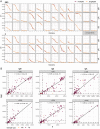Highly Sensitive and Specific Multiplex Antibody Assays To Quantify Immunoglobulins M, A, and G against SARS-CoV-2 Antigens
- PMID: 33127841
- PMCID: PMC8111153
- DOI: 10.1128/JCM.01731-20
Highly Sensitive and Specific Multiplex Antibody Assays To Quantify Immunoglobulins M, A, and G against SARS-CoV-2 Antigens
Abstract
Reliable serological tests are required to determine the prevalence of antibodies against severe acute respiratory syndrome coronavirus 2 (SARS-CoV-2) and to characterize immunity to the disease in order to address key knowledge gaps in the coronavirus disease 2019 (COVID-19) pandemic. Quantitative suspension array technology (qSAT) assays based on the xMAP Luminex platform overcome the limitations of rapid diagnostic tests and enzyme-linked immunosorbent assays (ELISAs) with their higher precision, dynamic range, throughput, miniaturization, cost-efficiency, and multiplexing capacity. We developed three qSAT assays for IgM, IgA, and IgG against a panel of eight SARS-CoV-2 antigens, including spike protein (S), nucleocapsid protein (N), and membrane protein (M) constructs. The assays were optimized to minimize the processing time and maximize the signal-to-noise ratio. We evaluated their performances using 128 prepandemic plasma samples (negative controls) and 104 plasma samples from individuals with SARS-CoV-2 diagnosis (positive controls), of whom 5 were asymptomatic, 51 had mild symptoms, and 48 were hospitalized. Preexisting IgG antibodies recognizing N, M, and S proteins were detected in negative controls, which is suggestive of cross-reactivity to common-cold coronaviruses. The best-performing antibody/antigen signatures had specificities of 100% and sensitivities of 95.78% at ≥14 days and 95.65% at ≥21 days since the onset of symptoms, with areas under the curve (AUCs) of 0.977 and 0.999, respectively. Combining multiple markers as assessed by qSAT assays has the highest efficiency, breadth, and versatility to accurately detect low-level antibody responses for obtaining reliable data on the prevalence of exposure to novel pathogens in a population. Our assays will allow gaining insights into antibody correlates of immunity and their kinetics, required for vaccine development to combat the COVID-19 pandemic.
Keywords: COVID-19; IgA; IgG; IgM; Luminex; RBD; SARS-CoV-2; antibody; coronavirus; immunity; immunoassay; multiplex; nucleocapsid; performance; quantitative suspension array technology; sensitivity; specificity; spike.
Copyright © 2021 American Society for Microbiology.
Figures





Similar articles
-
Longitudinal detection of SARS-CoV-2-specific antibody responses with different serological methods.J Med Virol. 2021 Oct;93(10):5816-5824. doi: 10.1002/jmv.27113. Epub 2021 Jun 11. J Med Virol. 2021. PMID: 34061367 Free PMC article.
-
Detection of SARS-CoV-2-specific antibodies via rapid diagnostic immunoassays in COVID-19 patients.Virol J. 2021 Mar 9;18(1):52. doi: 10.1186/s12985-021-01530-2. Virol J. 2021. PMID: 33750394 Free PMC article.
-
Analysis of Serological Biomarkers of SARS-CoV-2 Infection in Convalescent Samples From Severe, Moderate and Mild COVID-19 Cases.Front Immunol. 2021 Nov 19;12:748291. doi: 10.3389/fimmu.2021.748291. eCollection 2021. Front Immunol. 2021. PMID: 34867975 Free PMC article.
-
Serological assays and host antibody detection in coronavirus-related disease diagnosis.Arch Virol. 2021 Mar;166(3):715-731. doi: 10.1007/s00705-020-04874-2. Epub 2021 Jan 25. Arch Virol. 2021. PMID: 33492524 Free PMC article. Review.
-
SARS-CoV-2 antibody testing for estimating COVID-19 prevalence in the population.Cell Rep Med. 2021 Feb 16;2(2):100191. doi: 10.1016/j.xcrm.2021.100191. Epub 2021 Jan 14. Cell Rep Med. 2021. PMID: 33521694 Free PMC article. Review.
Cited by
-
Persistence and baseline determinants of seropositivity and reinfection rates in health care workers up to 12.5 months after COVID-19.BMC Med. 2021 Jun 28;19(1):155. doi: 10.1186/s12916-021-02032-2. BMC Med. 2021. PMID: 34183003 Free PMC article.
-
SARS-CoV-2 RapidPlex: A Graphene-Based Multiplexed Telemedicine Platform for Rapid and Low-Cost COVID-19 Diagnosis and Monitoring.Matter. 2020 Dec 2;3(6):1981-1998. doi: 10.1016/j.matt.2020.09.027. Epub 2020 Oct 5. Matter. 2020. PMID: 33043291 Free PMC article.
-
RBD-Based ELISA and Luminex Predict Anti-SARS-CoV-2 Surrogate-Neutralizing Activity in Two Longitudinal Cohorts of German and Spanish Health Care Workers.Microbiol Spectr. 2023 Feb 14;11(1):e0316522. doi: 10.1128/spectrum.03165-22. Epub 2023 Jan 9. Microbiol Spectr. 2023. PMID: 36622140 Free PMC article.
-
Seven-month kinetics of SARS-CoV-2 antibodies and role of pre-existing antibodies to human coronaviruses.Nat Commun. 2021 Aug 6;12(1):4740. doi: 10.1038/s41467-021-24979-9. Nat Commun. 2021. PMID: 34362897 Free PMC article.
-
Two-dimensional multiplexed assay for rapid and deep SARS-CoV-2 serology profiling and for machine learning prediction of neutralization capacity.bioRxiv [Preprint]. 2021 Aug 4:2021.08.03.454782. doi: 10.1101/2021.08.03.454782. bioRxiv. 2021. PMID: 34373852 Free PMC article. Preprint.
References
-
- Zhu N, Zhang D, Wang W, Li X, Yang B, Song J, Zhao X, Huang B, Shi W, Lu R, Niu P, Zhan F, Ma X, Wang D, Xu W, Wu G, Gao GF, Tan W, China Novel Coronavirus Investigating and Research Team. 2020. A novel coronavirus from patients with pneumonia in China, 2019. N Engl J Med 382:727–733. doi:10.1056/NEJMoa2001017. - DOI - PMC - PubMed
Publication types
MeSH terms
Substances
Grants and funding
LinkOut - more resources
Full Text Sources
Other Literature Sources
Medical
Miscellaneous

